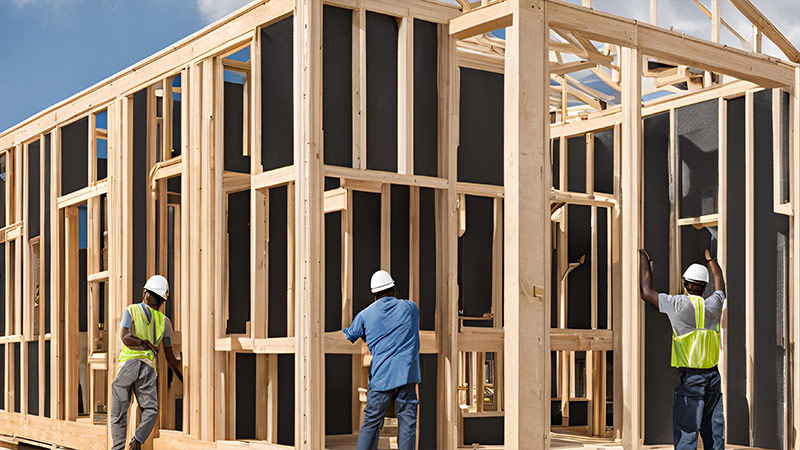What Types of Projects Are Best Suited for Off-Site Construction?
Author: OCRC
Posted on Jul 9, 2024
Category: Off-site Construction

You've likely heard the buzz about off-site construction and its many benefits - speed, quality, cost-efficiency, safety and environmental impact. But what kinds of projects are actually best suited for this innovative approach?
Understanding off-site construction
Before we get into the specifics, let’s quickly recap what off-site construction is. Essentially, it involves manufacturing and assembling building components away from the actual construction site. These prefabricated modules or panels are then transported to the site for final assembly, much like putting together a giant, life-sized Lego set.
Types of projects ideal for off-site construction
Off-site construction can be a game-changer for various types of projects. Here are some prime candidates:
- Residential buildings
- Single-family homes: Off-site construction is perfect for single-family homes, especially those in remote or challenging locations. Modules can be built in a factory with precise specifications and then transported to the site for quick assembly.
- Multi-family apartments: For multi-family apartments, off-site construction can significantly speed up the build time and ensure consistent quality across all units. This is particularly useful for large housing developments.
- Affordable housing: Off-site construction is ideal for affordable housing projects, as it offers cost-effective solutions and rapid construction timelines. By manufacturing components in a controlled factory environment, high-quality and durable homes can be produced quickly and efficiently, meeting the urgent demand for affordable housing.
- Single-family homes: Off-site construction is perfect for single-family homes, especially those in remote or challenging locations. Modules can be built in a factory with precise specifications and then transported to the site for quick assembly.
- Commercial buildings
- Office buildings: Off-site construction can help reduce disruption in busy commercial areas by minimizing the on-site construction phase. Prefabricated office modules can be assembled quickly, allowing businesses to get up and running faster.
- Retail spaces: Retail projects benefit from off-site construction due to the speed and flexibility it offers. Whether it’s a single store or a chain of stores, prefabricated elements can ensure a consistent look and feel while speeding up the opening process.
- Office buildings: Off-site construction can help reduce disruption in busy commercial areas by minimizing the on-site construction phase. Prefabricated office modules can be assembled quickly, allowing businesses to get up and running faster.
- Educational facilities
- Schools and classrooms: Schools often need to expand quickly to accommodate growing student populations. Off-site construction allows for rapid deployment of new classrooms or even entire school buildings, reducing disruption to ongoing educational activities.
- Schools and classrooms: Schools often need to expand quickly to accommodate growing student populations. Off-site construction allows for rapid deployment of new classrooms or even entire school buildings, reducing disruption to ongoing educational activities.
- Healthcare facilities
- Hospitals and clinics: Healthcare facilities require high-quality, precise construction. Off-site construction can meet these demands while reducing the time needed to get vital services up and running.
- Hospitals and clinics: Healthcare facilities require high-quality, precise construction. Off-site construction can meet these demands while reducing the time needed to get vital services up and running.
- Hospitality industry
- Hotels and motels: The hospitality industry is increasingly turning to off-site construction to build hotels faster and more efficiently. Prefabricated hotel rooms can be assembled off-site and then transported for quick assembly, ensuring a high level of consistency and quality.
Why these projects work well
- Repetitive designs: Projects with repetitive designs, such as multi-family apartments or hotel rooms, benefit from the standardized process of off-site construction. Consistency and quality control are easier to manage in a factory setting.
- Speed and efficiency: Time-sensitive projects, such as schools or healthcare facilities, need to be completed quickly without compromising quality. Off-site construction meets these demands by overlapping on-site and off-site work.
- Remote locations: For projects in remote or difficult-to-access areas, like some residential or industrial sites, off-site construction minimizes the logistical challenges of transporting workers and materials.
Off-site construction is revolutionizing how we approach a wide range of building projects. From residential homes and commercial buildings to educational facilities and healthcare centers, the versatility and efficiency of this method are undeniable. By leveraging modern technology and innovative practices, off-site construction is setting new standards in the construction industry.
If you’re considering a new project and want to explore the benefits of off-site construction, it might just be the perfect solution. Take a look at our Project Profiles to see real-world examples of off-site construction in action with our industry partners.
Interested in exploring the potential of off-site construction methods for your next project? Reach out to us at offsiteconstruction@unb.ca to collaborate – whether you’re looking to modularize your design, improve the productivity of your manufacturing facility, or start a new off-site construction endeavour.
